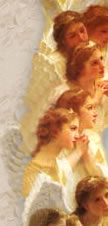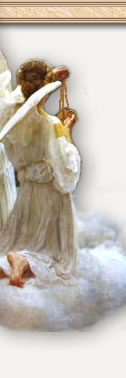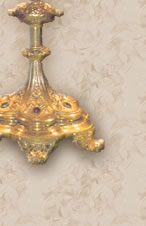 What is the Traditional Latin Mass? What is the Traditional Latin Mass?
For nearly 1,400 years, the Traditional Latin Mass was the Liturgy of the Catholic world. It was the Mass at which practically every Pope, and Saint and Christian of the West worshipped from 600 A.D. to 1970 A.D.
It was the Mass that Catholic martyrs gave their blood to preserve during the Protestant Reformation. It was the Mass that united Christians across Continents and across centuries. It has been described as "the most beautiful thing this side of heaven."
 Why has the Traditional Latin Mass returned? Why has the Traditional Latin Mass returned?
With the crises in the world today, more and more people (especially young people) seek an alternative to the "modern world." They are returning in droves to the wisdom of the ages, to things tested and timeless.
For many young Catholics and
converts to the Catholic Faith,
this has included a return to
the Traditional Latin Mass.
Recognizing that the Traditional
Latin Mass has never been
abolished or forbidden, Pope
Benedict XVI affirms in his July
7, 2007 Motu Proprio entitled "Summorum
Pontificum" the right of every
Catholic priest in the world to
offer this Mass.
 How does the Traditional Latin Mass differ from the New Mass? How does the Traditional Latin Mass differ from the New Mass?
Perhaps the first difference that one will notice is the use of Latin at the traditional Mass -- the official language of the Church. Over the centuries, Latin has helped unify Catholics from different countries and backgrounds.
The second major obvious difference is that in the Traditional Latin Mass, the priest, like the rest of the congregation, faces East ("ad orientem"). East is the direction of the rising Sun, which is symbolic of the Risen Christ. This means that for much of the Mass, the priest’s back is toward the congregation.
This demonstrates the unity of the priest and the parishioners in worshipping God together. After all, Mass is not about the priest’s interaction with the congregation, but rather about interaction with God Himself.
The third major difference concerns Holy Communion. At the Traditional Latin Mass, Holy Communion is received by parishioners on the tongue, and kneeling.
This traditional form of receiving the Eucharist stresses the awesome reality that Holy Communion is indeed the Body of Christ, and should be received with the utmost of reverence.
Lastly, the music that one will hear at the Traditional Latin Mass will include solemn Gregorian Chant – the official music of the Church.
This is in place of guitars and other modern instruments (and tunes) that were introduced with the new Mass.
Overall, most Catholics who attend the Traditional Latin Mass characterize the differences noted above, along with some others, as creating a greater "sense of the sacred" at the Traditional Latin Mass.
 Do I need to know Latin to follow the Traditional Latin Mass? Do I need to know Latin to follow the Traditional Latin Mass?
No. Latin-English Missals contain easy-to-follow, step-by-step translations of all the prayers, hymns, and responsorials of the Mass. The homily will be in English, and the scriptural readings will be read in both English and Latin.
Latin-English Missals
are always available for your use.
 How do I use the Traditional Latin Missal? How do I use the Traditional Latin Missal?
The Latin-English Booklet Missal lays out, in easy-to-follow format, the structure and prayers of the Mass. There are two sets of prayers at Mass: the ordinary prayers, and the proper prayers.
The ordinary prayers are those fixed prayers that repeat week after week, and will be contained in the Missal. The proper prayers, which change from week to week, will be provided to you via handout each Sunday.
|





















